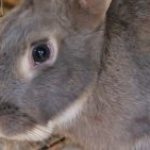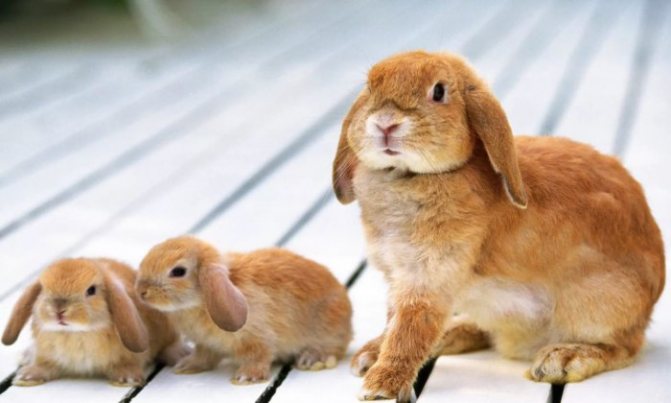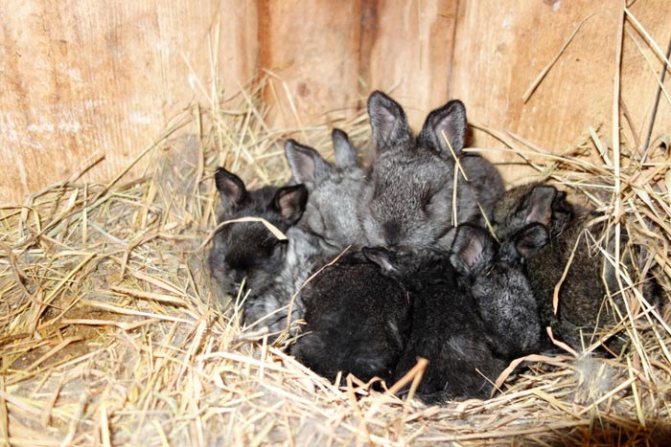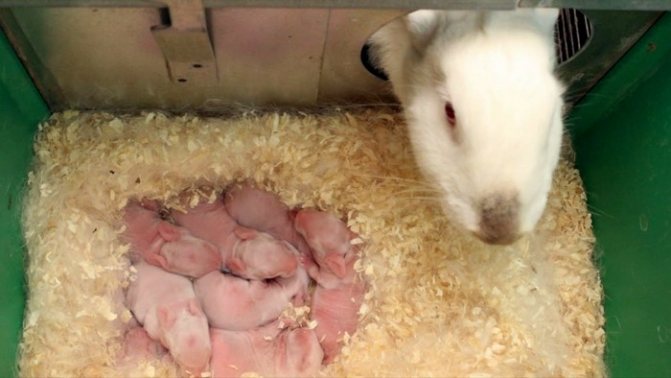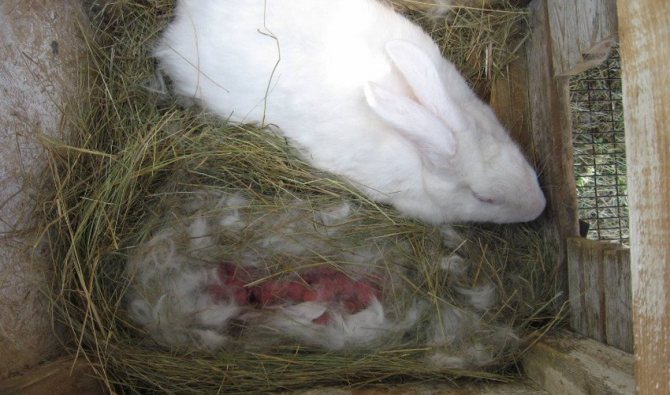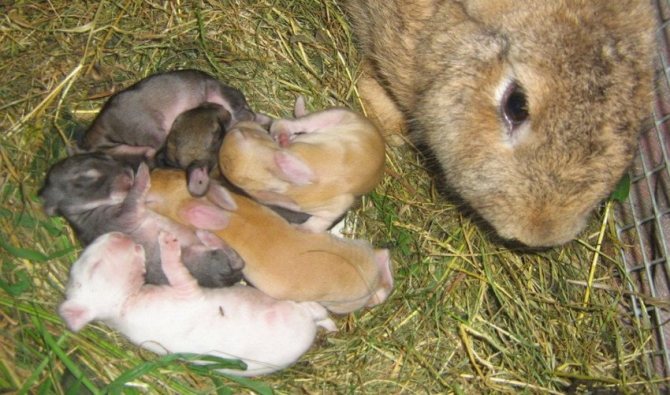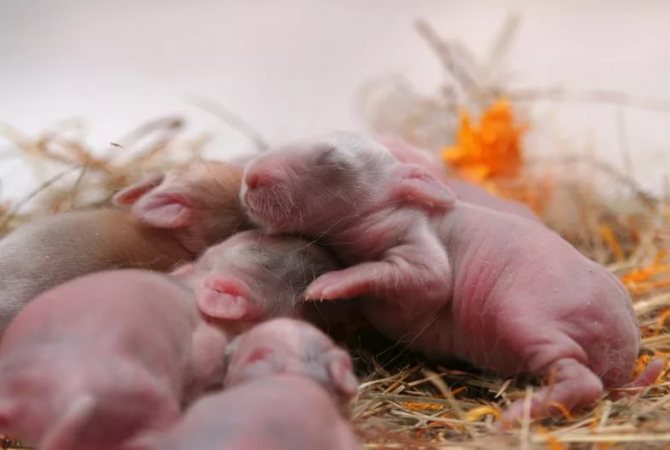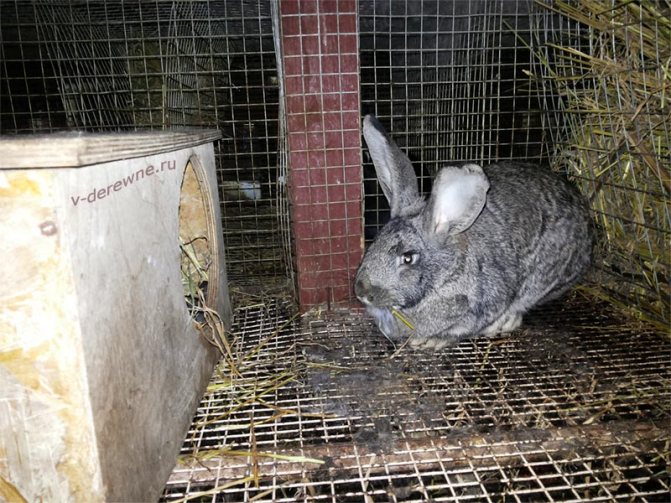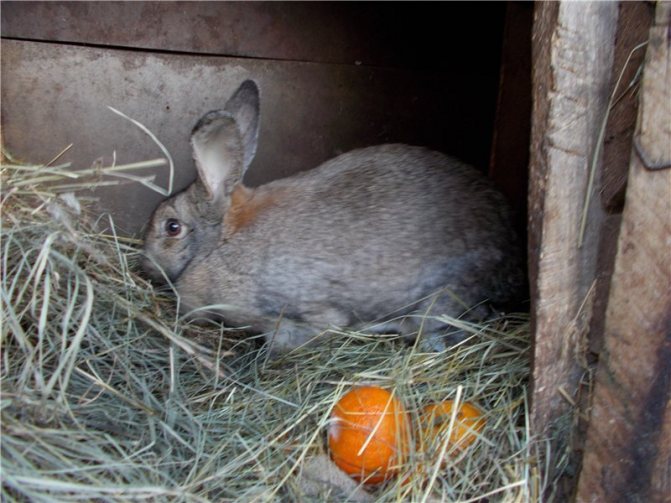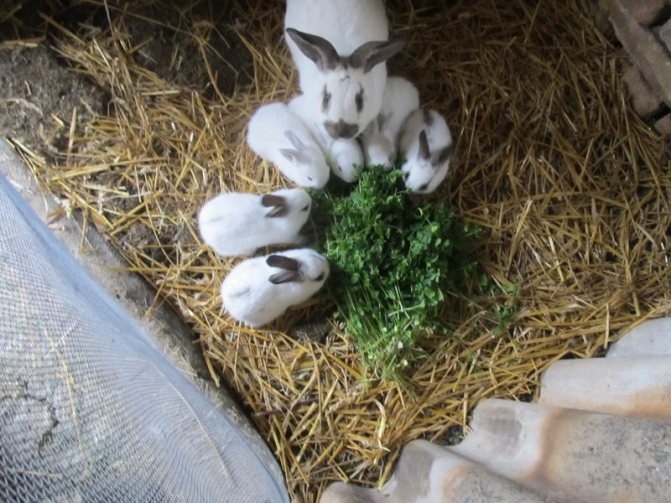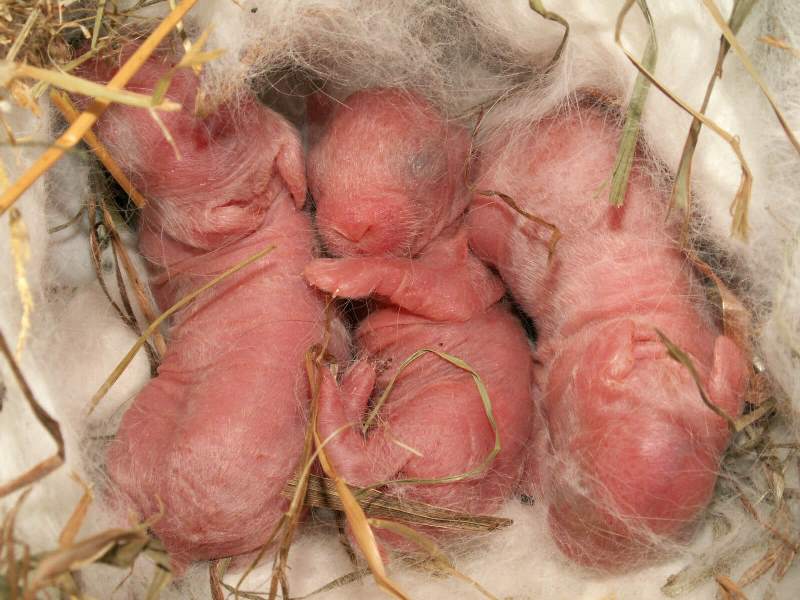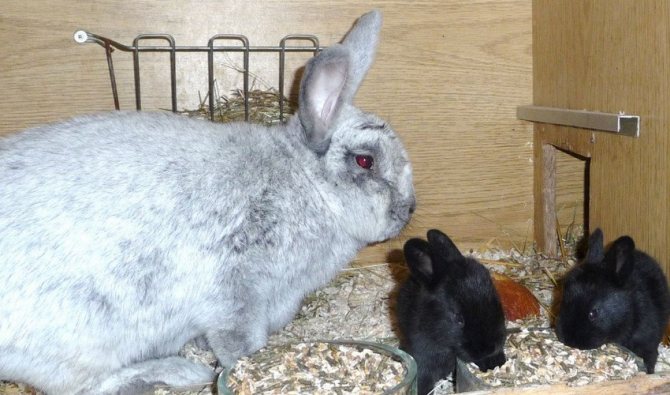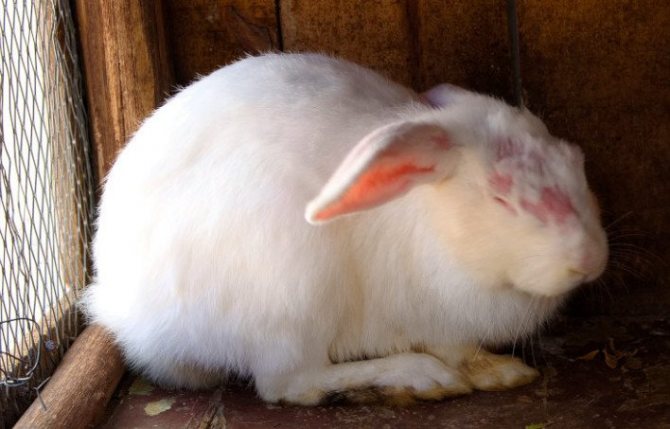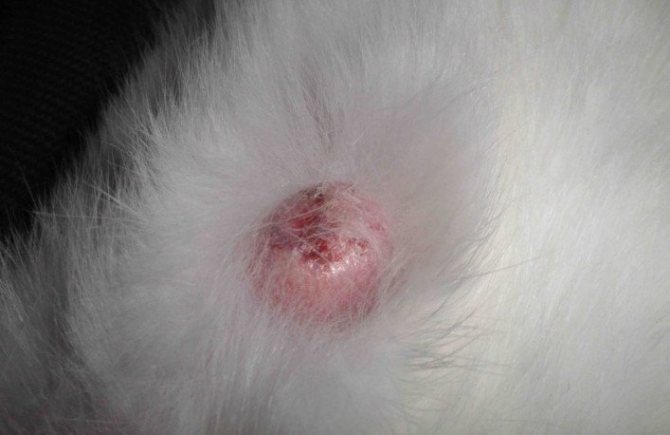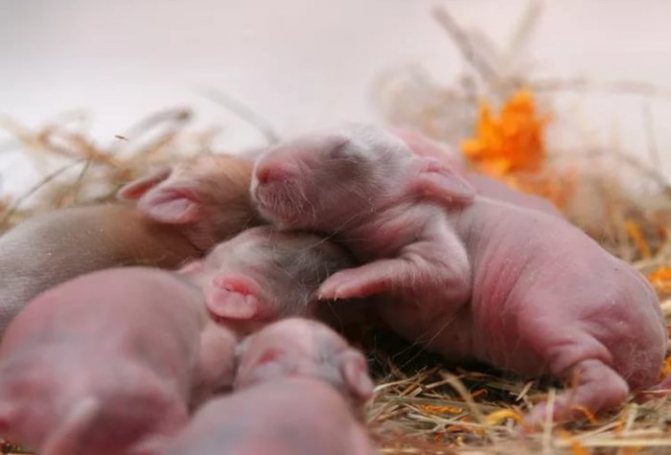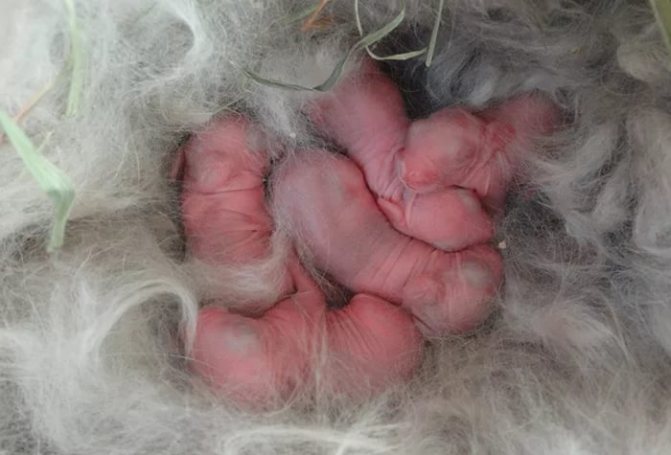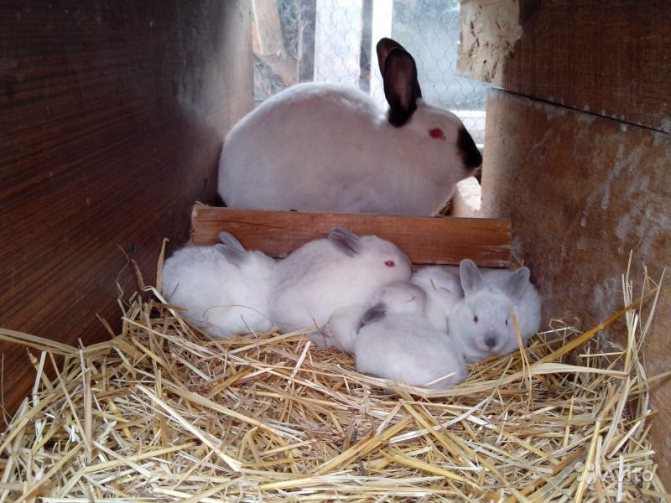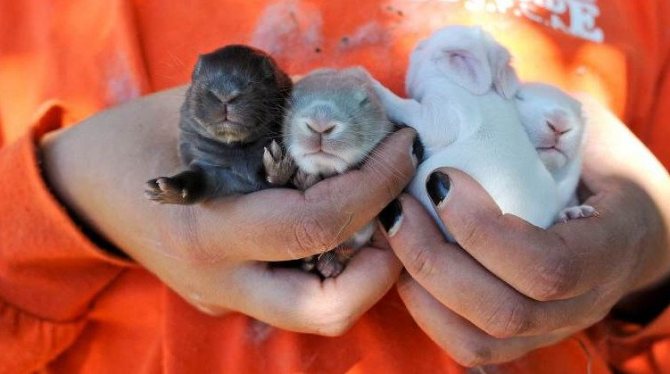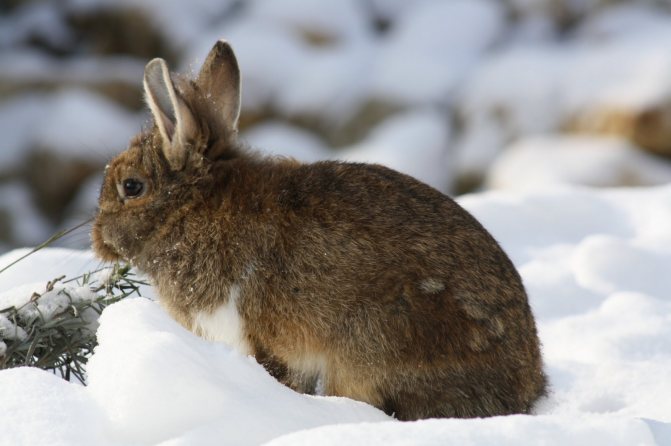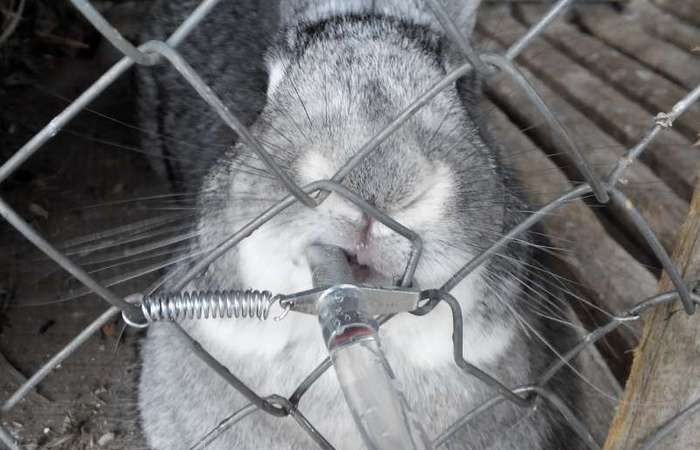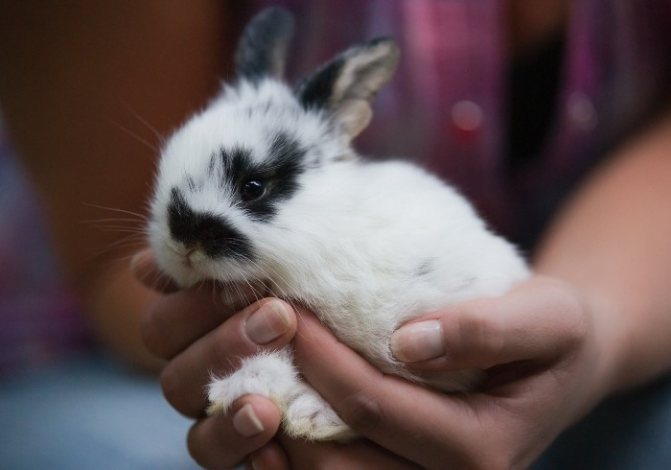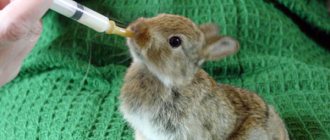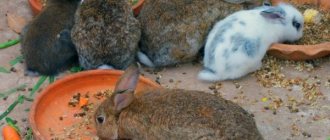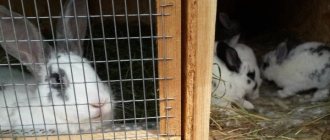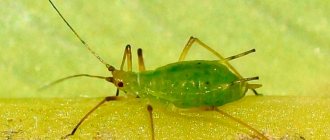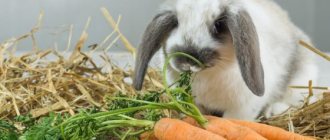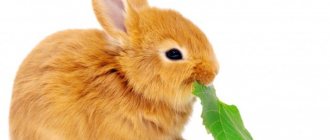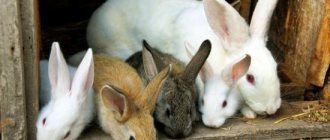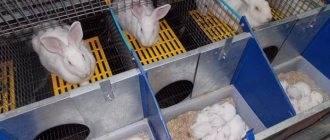Rabbits and maternal instinct
Females responsibly prepare for childbirth. For several days, the rabbits equip the nest. Grass, hay, feathers are taken as material. They always pluck the fluff from the belly and lay it in the nest.
The concern continues on and on. The female removes the amniotic membrane from the newborn rabbits, gnaws through the umbilical cord.
Then, in the daytime, the concern disappears. This is a trick - the rabbit does not draw attention to the nest with offspring. In fact, she takes care of the little ones when the “enemies” cannot see. This is a protective instinct passed down from wild ancestors.
Checking a female's real intentions is easy. If the rabbits are in the nest and do not squeak, they are sleeping, then they were well fed. The bellies should not be wrinkled, but slightly puffed up.
It is unlikely that the females do all this work in order to then eat the rabbits. The maternal instinct is naturally well developed. It's just that sometimes it crashes.
What can be done to prevent such cases?
The rabbit breeder is obliged to establish a full-fledged feeding of the females, whose body is under tremendous stress.
The diet should consist of:
- high-quality cereal-legume hay or dried grass;
- a grain mixture consisting of oats, barley, corn (up to 300 g per day);
- fresh vegetables: carrots, pumpkin.
Rabbits are given complex vitamins by adding them to water or grain mixture. The cage must contain a piece of salt - a lick.
Important! There should always be water in the cage of a felted female! Snow in winter cannot replace water for the rabbit.
Other preventive measures:
- Protect rabbits from external noise. The rabbitry or cages are placed in a quiet and secluded place on the site.
- It is recommended to examine the rabbits in the absence of the mother in the cage. Extraneous odors should not remain in the nest and on babies.
- The cage with rabbits must be reliably protected from the penetration of predators. Traps are set under the cages.
- The hole in the nest box is provided with a side 2.5-4 cm high. It will prevent the rabbit from being accidentally sucked out of the nipple.
- A female rabbit that has come into the hunt should be covered, although the combination of lactation and pregnancy is not beneficial for the health of the animal. The breeder should remember that the presence of an adult male in a cage adjacent to the female can provoke an early manifestation of hunting.
- One day after birth, the female's nipples should be examined for inflammation.
- When a large number of rabbits are born (more than 10), the extra ones (the smallest and weakest) are removed.
- Young primiparous females are given close attention: they help to cover the nest with hay, and they pull down the rabbit's fluff if she has not done so.
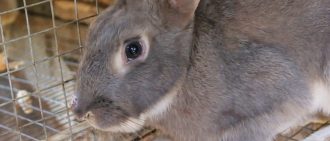
Be sure to read:
Myxomatosis prevention and treatment in rabbits, symptoms of the disease, is it possible to eat meat
Reasons for eating newborn rabbits
The death of offspring is a serious problem. For a solution, first find out why this is happening. Bunnies eat their young for the following reasons:
- Lack of maintenance and improper diet, in which the animal lacks vitamins, minerals, proteins. After giving birth and in front of them, the rabbits are very thirsty. It is important to provide them with water. If the owner missed this moment, the female eats the offspring in order to obtain the necessary substances.
- Rough nipples, lack of milk or lack of milk. Sometimes it is explained by the lack of diet. In other cases, the reason lies in the characteristics of the body. Often females who have not given birth before suffer from this problem. Rabbits do not eat all the offspring. They choose those that are weaker, then the rest have enough milk.
- Females get rid of non-viable rabbits. Sometimes the animal feels that some of the cubs are sick, weak and will not survive. In nature, the smell of a corpse attracts predators, which can destroy not only weak cubs, but everyone else along with their mother. Corpses are germs, diseases. The bunny instinctively gets rid of danger when she eats the bunnies. Moreover, it will not work to bury them in a cage. Some babies are already born dead. They are eaten for the same reasons. Plus, maternal forces are not wasted on weak rabbits, which can be given to promising babies.
- Sometimes the cubs die for some other reason. For example, the owner did not take care of insulation, and they froze. The rabbit gets rid of corpses according to the rules of the wild.
- Severe stress. Rabbits are shy animals. They are unnerved by loud noises, for example, a dog barking, the owner's abuse, a change of scenery, unfamiliar smells, and more.
- Inexperience of the female. The firstborn carelessly looks after, gnaws at the umbilical cord. The rabbits are injured and die. If some blood, for example from the umbilical cord, gets into the mouth, the young female sometimes cannot stand it. Because of a strong, unusual thirst, she eats a rabbit or two.
- Accident. The rabbit abruptly rushes to the cubs, protects them, for example, during a noise. Some die under the weight of the mother's body. You have to eat them.
- Unknown reasons. The cases are repeated in specific animals.
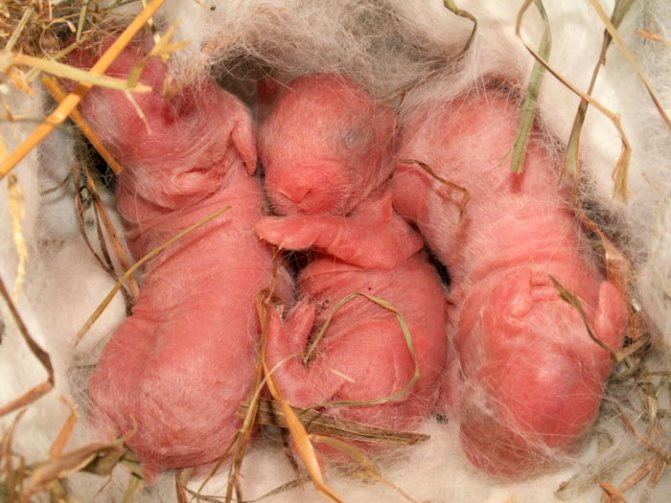

When instinct fails
The maternal instinct is a set of behavioral norms based on the desire to protect and preserve the offspring. Thanks to this, animals are able to survive and reproduce in the wild. However, very often more than half of the offspring do not survive in natural conditions. That is why the frequency of okrol is 4-5 times a year.
Why does maternal instinct disappear in females at home?
A common reason for this is the reduced risk of hazard. A rabbit raised on a farm does not feel the threat from the outside world as well as in the wild, and therefore is less interested in protecting her cubs. There are other possible reasons for the loss of instinct:
- stress after childbirth, especially after the first;
- cramped, muddy or poorly equipped nest;
- too many people;
- foreign smells and loud sounds;
- bustling surroundings;
- the presence of domestic predators (cats, dogs).
In any case, it is impossible to establish the exact cause of the loss of the maternal instinct. This happens individually for each individual, the answer to the question "what to do?" is also individual.
The rabbit can stop feeding and destroy defective individuals.
Sometimes the cub can be eaten if the female accidentally crushed him. It is also one of the primary instincts. The corpse of a bunny can attract the smell of a predator to the nest. By the way, dead rabbits can be eaten not only by the rabbit, sometimes rats or birds of prey do it.
In addition to the loss of the maternal instinct, the reason for eating the offspring can be a lack of water. The animal's body is severely dehydrated during childbirth, so you need to make sure that the pet has access to water during the birth, otherwise the rabbit will look for a way to replenish the lack of body fluids herself, and the easiest way out will be to decide to eat the baby bunnies.
Very often, female rabbits can harm their cubs due to increased aggression. Its reason is the desire to protect the rabbits from possible danger.It is not necessary to touch the cubs and the female during feeding, it is important to surround them with a calm environment. The rabbit must feel completely safe, otherwise she often rushes to the aid of the offspring and often crushes him. Sometimes rabbits begin to eat cubs if more than 6 of them were born in the litter. Such babies are usually weaker and the female considers them unfit for life.
Why does the bunny scatter bunnies
Sometimes females forget about their maternal responsibilities. They do not look after the cubs, they scatter those who get in the way. There are reasons for this behavior too:
- Stress. When it is too strong, the instinct of self-preservation supplants the maternal instinct. Due to constant fear and shock, the mother forgets about the children, so she scatters them.
- When there is a problem with milk. Bunnies do not necessarily kill the young immediately. Sometimes they are simply not fed, ignored, shoved. It happens that when feeding, the female experiences pain, for example, with mastitis. It happens that there is enough milk, but it is not used, the nipples are not developed. Then not only hungry babies can die, but also the mother.
- Sexual hunting. The other instinct becomes stronger than the maternal one. The rabbit does not kill cubs. She worries, scatters them, accidentally crushes them, does not feed them. Then he gets rid of the corpses.
- Inexperience. Young females sometimes find it difficult to get used to the new role immediately after the first birth.
- Didn't have time, forgot or couldn't make a nest. The female fusses, is engaged in construction and at the same time scatters offspring.
Refusal of a female from cubs and harming them: what to do?
The refusal of the female from the cubs is visible almost immediately: she scatters the rabbits, rushes about, sometimes crushes them. In this case, the babies should be placed next to another rabbit, and this should be done quickly and accurately. The mother, who has abandoned the offspring, is deposited in another enclosure, and the rabbits are put in to the recently given birth to the female. In order for the other rabbit to perceive the refuseniks normally, you can process the cubs and your own hands with wormwood. It is harmless to newborns and obstructs human odor. After a few minutes, you need to check: if the female did not start scattering the rabbits, then the adoption was successful.
Sometimes the reason for refusal can be a poor lactation in a rabbit. In this case, it is worth checking the female for mastitis. Breast massage can also help.
From all of the above, we can conclude: a rabbit is able to eat her little rabbits for many reasons. It could be natural instincts, an inappropriate breeding site, or postpartum stress. With proper preparation for the litter process, the risk of eating the litter is extremely low. It is also extremely important for humans to control the process of birth and feeding of rabbits. Rabbits are not carnivores and the female will not eat her offspring for no reason.
Can a rabbit eat monthly bunnies
Newbie farmers sometimes do not find cubs in the nest, which are already 30 days old. By the way, many experienced specialists are already removing young animals at this age from their mothers. You can keep it longer, but then the female does not have time to recover for the next birth.
Monthly rabbits are active and curious. They often escape from the nest. They check the premises, surroundings.
The female no longer eats such large cubs. In some cases, ferrets, weasels, rats, cats are to blame. They find the victim in the nest or lie in wait somewhere nearby. Sometimes a runaway rabbit is in danger. It is important to monitor the young and organize protection from animals.
In the wild
In the forest, the eared eared cannot afford to raise defective offspring, therefore, at the slightest hint of this, the female stops feeding and destroys the rabbits. The same thing happens if the litter is too large. Cubs in this case are born smaller and weaker.
For a rodent, this serves as a signal for the poor vitality of the rabbits, and the female kills them without a shadow of a doubt. We propose to consider in more detail the reasons why the bunny eats her bunnies, as well as ways to avoid this trouble.
Solution of problems
When the cause is clear, it is removed. Sometimes the bunny eats the little rabbits for unknown reasons. Such an individual is not allowed to breed. For the rest, the decisions depend on the reasons.
Stress protection
The female is placed in calm conditions. Stress protection boils down to the following:
- Baby rabbits are taken in their arms only as a last resort. Due to the human smell, females sometimes do not recognize the cubs. To prevent this from happening, you can put on gloves, rub the rabbits with the mother's fluff. Some people advise using wormwood to fight off other odors.
- Protect from noise.
- Do not allow animals and people to be disturbed.
- It is advisable that one person takes care of the mother and the offspring. The animals get used to it.
- Do not allow a sudden change of scenery. Sometimes the stress is caused by being placed in another cage at the wrong time.
- Do not sharply adjust the diet. This is also an additional reason for stress, after which the rabbits eat their cubs.
- Do not change the litter in the nest for a week after giving birth. In general, they look into the mother cell as little as possible.
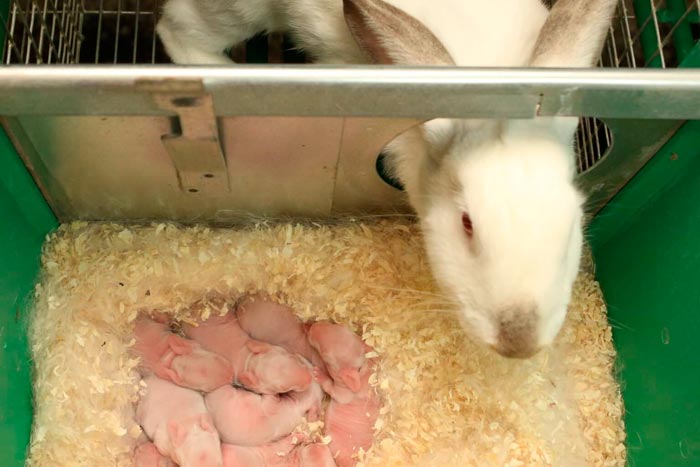

Proper feeding and drinking
So that the rabbit does not eat the cubs, they adjust the diet. Particular attention is paid to water. It should always be freely available. Water quality is monitored. The drinker is washed before each filling. Change the water daily.
Provide enough food. So that the rabbit does not eat the rabbits, the food must be more than nutritious. It is important to ensure that there are enough vitamins, minerals, proteins. They give hay, root crops, special feeding and so on.
As a result, the female no longer needs to eat her newborn rabbits. Of course, diet is not the only reason, but perhaps the most common.
Psychological deviation
Sometimes the problem is in the internal state of the animal. The lack of maternal instinct is often manifested in females that have not given birth before. They don't feel like mothers. As a rule, such psychological deviations go away on their own over time.
Insufficient experience is indicated by some damage. A killed rabbit sometimes has a gnawed stomach or head. In the first case, the umbilical cord was probably ineptly gnawed, in the second, the amniotic membrane was removed.
Sometimes the female is taught to motherhood by force: she is held on her side, back, and hungry rabbits are placed, pressed to the nipples. The cubs are planted one at a time. As a rule, after 3-4 attempts, the rabbit accepts offspring. Although the method does not always work.
Unused milk from a psychologically unprepared female is harmful to health. Sometimes hardened nipples are lubricated with vegetable oil, massaged. For serious problems, such as mastitis, contact your veterinarian.
If the maternal instinct does not wake up, they give the cubs to another female. In some cases, they feed themselves from a pipette or syringe.
Satisfaction of the sex drive
Sometimes the rabbit is worried, runs around the cage, does not eat, arches her back and behaves aggressively. This means that the hunt has begun. The exact sign is a swollen genital loop.
In such a state, the rabbit does not care about the offspring: she scatters, crushes, does not feed. The only way out is to give it to the male for a while.
After mating, the would-be mother calms down. The female becomes an exemplary mother again. During her absence, her duties are "performed" by the farmer.
If there are other lactating females, you can give the offspring to them for upbringing. As a rule, female rabbits accept other people's cubs. Here, the following are taken into account:
- Age. The difference between relatives and foster rabbits is up to 2-3 days.Although it happens that females accept newborns when they are already about a month old. Much depends on the nature of a particular individual.
- Number. After replanting, a maximum of 8 rabbits should be obtained. This is due to the number of nipples. Although females sometimes feed more. Depends on the body. Supports animals with succulent feed to increase lactation.
- New rabbits are carefully camouflaged. The smell and so on are important. The female is removed. Foster cubs are rubbed and covered with fluff from the nest. They are placed in the mother liquor so that they are surrounded by relatives. The mother is returned in 30–90 minutes.
The disadvantage of this method is stress. Although, as a rule, everything ends well.
Additional recommendations
Everyone knows that the best treatment is prevention. And so that the question does not arise why the rabbit kills the rabbits, you should carefully prepare for such an important matter as okrol. And so it's time for a couple of recommendations that will help in this matter.
- Firstly, the rabbit and the rabbit participating in the mating should be calm, balanced, without any diseases. This will ensure the birth of healthy offspring, as well as reduce the likelihood that the rabbit will eat the babies.
- Secondly, why does the bunny eat bunnies? Because she has a lack of any substances. Therefore, in order to avoid, her diet should contain vitamin supplements, along with compound feeds and herbs.
- Thirdly, it is impossible to disturb the female even after the birth. She will separate the dead and weak babies herself. As well as will carry out cleaning independently. Therefore, you can even look into the mother cell only on the second or third day, and even then, as imperceptibly as possible. And this should be done by a person familiar to the rabbit, whom she trusts.
Arrangement of the nest
Sometimes they help the female in preparing the mother liquor. When the reason for eating is unsuccessful arrangement, it is easy to find it. Do the following:
- They put building materials in the nest: hay, rabbit fluff. The female finds use for them. Perhaps the finished part of the nest will appeal to her.
- The rabbit nibbles fluff from the belly. Sometimes they do it instead. Ready-made fluff also saves time.
When the nest is completed, the female calms down and begins the main maternal duties: feeding, warming the cubs. If there are no other problems, the offspring are safe.
When the rabbit ate the rabbits or scattered them, they urgently take action. This means health or maintenance problems. As a rule, they are eliminated if the reasons are found.
Helping rabbits
A week before the okrol, a box is brought into the cage, chicken feathers and straw are put there. The female does the rest on her own: she peels the fluff around the nipples and adds hay to the nest.
The discarded rabbits are collected and put in a nest, covered with fluff. Before that, they are warmed in a separate room. If the mother does not accept the babies, they are assigned to another nursing female.
With mastitis, hard and reddened nipples are gently massaged. The first drops of milk are decanted by hand. If the pain persists, the specimen is shown to the veterinarian.
():
For some types of mastitis, massage is strictly contraindicated - this can lead to serious consequences. Therefore, if soreness of the mammary glands is detected, the rabbit should be examined by a doctor and determine the type of inflammation.
If the mother needs a rabbit, she is transferred to his cage for a day, and then returned to the cubs. If nothing has changed, babies are transferred to artificial feeding. They are fed with a pipette.
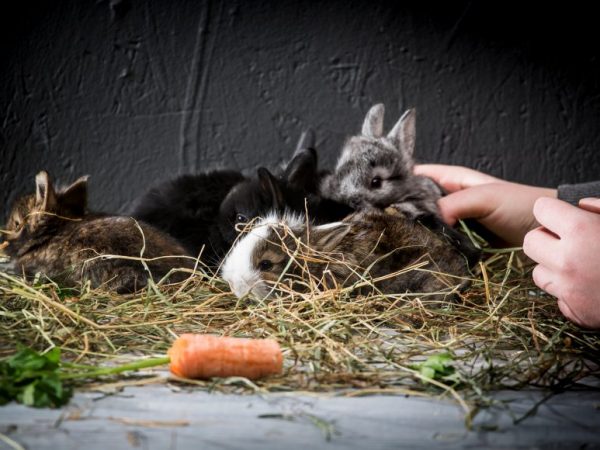

You can put the offspring on another female. But in order for a mother to accept other people's cubs, their age must coincide with the age of her own offspring.
At the next birth, it is required to observe how the female accepts the cubs. In case of refusal, the female is no longer used for breeding.The primiparous individual does not immediately accept the offspring, because it is not used to it. Small rabbits are removed from the mother for a day, then returned to the nest. If there are strange smells in it, then they put a branch of wormwood, then the female calms down.
after birth, it is required to check if there are stillborn cubs. Before the procedure, hands are washed with soap so that the individual does not throw out the newborns. The smell of man scares off the female. Dead rabbits are removed from the cage.
If the female still scatters the rabbits, they are transplanted into the nest with another nursing rabbit. Before that, the kids are cleaned of sawdust and fluff. It is important to plant them next to other cubs so that the female takes them for her own. After the lactating rabbit is brought into the cage.
():
Bunnies that are added to others should be about the same age. Allowable difference is 2-3 days. Before placing the babies in someone else's cage, they are lightly rubbed with the fluff of the "new" dairy mother.
If the breeder's farm does not have a dairy rabbit, then the eared offspring are fed artificially with the help of cow, goat or dry rabbit milk.
First, milk is dripped onto the finger, then the cubs are fed through a pipette. Do this up to 6 times a day. On the first day of feeding, they should consume 5 ml of this product. The dose is increased daily. At the age of twenty days, they switch to nipples. Monthly babies are fed from a bowl.

